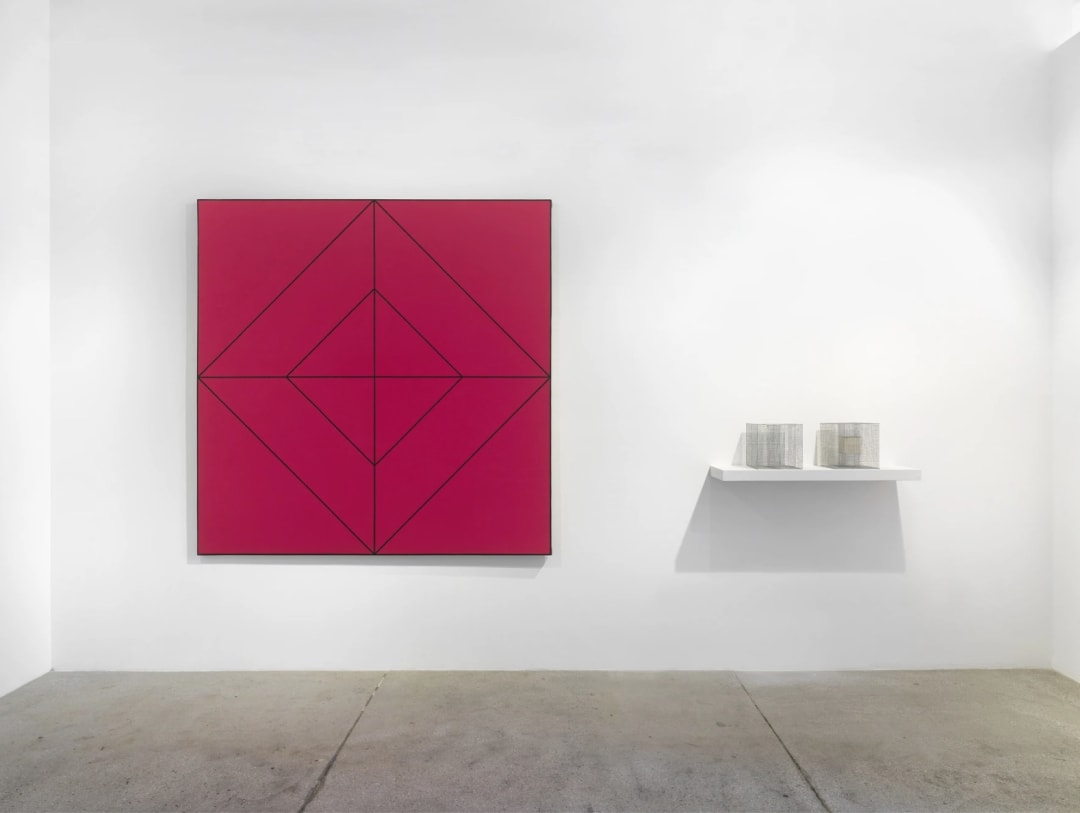Rakuko Naito, born in Tokyo, Japan, graduated from the Tokyo National University of Art in 1958, where she majored in traditional Japanese nihonga painting, an artform utilizing traditional Japanese materials . Following graduation, she moved to New York with her artist husband, Tadaaki Kuwayama and briefly attended the Art Students League in search of a less conventional method of working. During the early to mid-1960s, she made optical art and experimented with spray paint, masking tape and acrylic paint, a relatively new art material of the time which the American abstract painter, Sam Francis, introduced to her. Naito created works that emphasized flatness and downplayed the artist’s hand. By the mid-1960s when Optical (Op) art became popular with artists, Naito continued her experimental practices leading her to simple forms, flat monochromatic colors, and simple lines. This approach continues to inform her practice today.
Naito has experimented with integrating such materials as sand, nails, and wire into geometric, colorless works to explore texture and materiality. Naito’s work is characterized by a focused repetition of actions, decisions, and manipulation of forms, eschewing narrative. Her interest in geometry has continued into her works with paper: reflecting her interest in the natural forms and textures of the material that creates a reality which she views as transcending the limits of painting and drawing. For the past three decades, Naito has dedicated her artistic work to research into the malleability and strength of kozo and mino washi, traditional Japanese papers. The fibers that make up these types of papers are very strong, and their use can be traced back to the Nara period in 8th century Japan. Naito harmonizes traditional materials with a highly tactile and modern approach to sculpture. The artist's meticulous hand is in evidence in every piece of folded, torn, burnt, and applied piece of paper, culminating in the stunning work. As a result of her methodology, Naito’s work reaches somewhere between our notion of “drawing” and “sculpture.” With an innate preference for order and structure, Naito joins a circle of artists such as Mel Bochner, Eve Hesse and Sol LeWitt.
Naito’s first solo exhibition was at the World House Gallery, New York, in 1965. A recent solo exhibition was held at the Karuizawa New Art Museum (Karuizawa, Japan) in 2016.
Naito’s work has been included in group exhibitions such as the Mies-Van-der-Rohe Haus, “White Box,” Berlin, Germany., 2019; Monocromos: de Malevich al presente.,Museo Nacional Centro de Arte Reina Sofía, 2004; the International Women Artists' Biennale, Incheon, Korea 2009; Optic Nerve: Perceptual Art of the 1960s, Columbus Museum of Art, Columbus, Ohio 2007; Optical Edge, Pratt Manhattan Gallery, New York , 2007; A Moment Becomes Eternity, Bergen Museum, New Jersey,1993; Tokyo International Biennale (1974); Black & White, Wadsworth Atheneum Museum of Art, Hartford, Connecticut (1966); and Motion and Movement, Contemporary Art Center, Cincinnati, Ohio (1964).
Naito's work is included the following collections [ partial listing ]:
The Aldrich Contemporary Art Museum, Ridgefield, Connecticut; the Miami-Dade Community College, Miami, Florida; the Kemper Art Collection, Chicago; State University at Potsdam, New York; the Wellesley College Davis Museum, Wellesley, Massachusetts; the Museo de Arte Contemporaneo, Buenos Aires and the San Francisco Museum of Modern Art, SF, CA.
Naito was an artist in Residence at the Josef and Anni Albers Foundation in 2003.
Rakuko Naito lives and works in New York.
